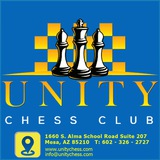Beverwijk, 1965. (Photo credit: H. van Gelderen / ANEFO.)
1st-2nd E. Geller (USSR) & L. Portisch (Hungary);
3rd M. Bobotsov (Bulgaria).
@UnityChess
1st-2nd E. Geller (USSR) & L. Portisch (Hungary);
3rd M. Bobotsov (Bulgaria).
@UnityChess
“Focusing on your strengths is required for peak performance, but improving your weaknesses has the potential for the greatest gains.”
🔸 Garry Kasparov "Deep Thinking: Where Machine Intelligence Ends and Human Creativity Begins."
@UnityChess
🔸 Garry Kasparov "Deep Thinking: Where Machine Intelligence Ends and Human Creativity Begins."
@UnityChess
🔴 Today is birthday of Alexander Khalifman
♦️ Russian chess Grandmaster
👏👏👏👏👏 Happy birthday 🌺💐☘️💐🌸🌷
. . . . . . . . . . . . .
@unitychess
♦️ Russian chess Grandmaster
👏👏👏👏👏 Happy birthday 🌺💐☘️💐🌸🌷
. . . . . . . . . . . . .
@unitychess
🔵 About Capablanca
🔹 José Raúl Capablanca
🔹 Third World Chess Champion
📚 José Raúl Capablanca y Graupera was a Cuban chess player who was world chess champion from 1921 to 1927. A chess prodigy, he is considered by many as one of the greatest players of all time, widely renowned for his exceptional endgame skill and speed of play.
🔘 Born: 19 November 1888
🔺 Havana, Cuba
🔘 Died: 8 March 1942 (aged 53)
🔺 New York City, New York, U.S.
📚 Nicknamed “The Human Chess Machine,” José Raúl Capablanca was born in Havana, Cuba. A true prodigy, he learned chess at age four and defeated Cuban champion Juan Corzo at 13. While attending Columbia University, he joined the Manhattan Chess Club and soon became its strongest player. He had a particular talent for rapid chess, defeating World Champion Emanuel Lasker in 1906. He eventually withdrew from Columbia to focus on chess.
His skill in rapid chess lent itself to simultaneous exhibitions. On a nationwide tour of 27 cities in 1909, he achieved a winning score of 96.9% over 607 games.
In 1913, Capablanca’s chess skills got him a job as an informal ambassador with the Cuban Foreign Office, representing Cuba at international events. He held exhibitions in London, Paris, and Berlin before his ultimate destination of Saint Petersburg in 1914, where he played and narrowly lost to Lasker.
World War I halted international competition, but Capablanca continued to compete and dominate, losing only one game between 1914 and 1924. In 1921, Capablanca and Lasker competed in the 3rd World Chess Championship, where Lasker resigned after losing four straight games.
🌐 SOURCE: WIKIPEDIA & WORLDCHESSSHOF
♦️ "The Left-Right Hook" named in chessgames.com site, a memorable game by Capablanca👇
▪️ David Janowski vs Jose Raul Capablanca
▪️ Rice Memorial (1916), New York, NY USA, rd 3, Feb-08
▪️ Slav Defense: Three Knights Variation (D15)
♦️ Review and download PGN file👇
. . . . . . . . . . . . .
@unitychess
🔹 José Raúl Capablanca
🔹 Third World Chess Champion
📚 José Raúl Capablanca y Graupera was a Cuban chess player who was world chess champion from 1921 to 1927. A chess prodigy, he is considered by many as one of the greatest players of all time, widely renowned for his exceptional endgame skill and speed of play.
🔘 Born: 19 November 1888
🔺 Havana, Cuba
🔘 Died: 8 March 1942 (aged 53)
🔺 New York City, New York, U.S.
📚 Nicknamed “The Human Chess Machine,” José Raúl Capablanca was born in Havana, Cuba. A true prodigy, he learned chess at age four and defeated Cuban champion Juan Corzo at 13. While attending Columbia University, he joined the Manhattan Chess Club and soon became its strongest player. He had a particular talent for rapid chess, defeating World Champion Emanuel Lasker in 1906. He eventually withdrew from Columbia to focus on chess.
His skill in rapid chess lent itself to simultaneous exhibitions. On a nationwide tour of 27 cities in 1909, he achieved a winning score of 96.9% over 607 games.
In 1913, Capablanca’s chess skills got him a job as an informal ambassador with the Cuban Foreign Office, representing Cuba at international events. He held exhibitions in London, Paris, and Berlin before his ultimate destination of Saint Petersburg in 1914, where he played and narrowly lost to Lasker.
World War I halted international competition, but Capablanca continued to compete and dominate, losing only one game between 1914 and 1924. In 1921, Capablanca and Lasker competed in the 3rd World Chess Championship, where Lasker resigned after losing four straight games.
🌐 SOURCE: WIKIPEDIA & WORLDCHESSSHOF
♦️ "The Left-Right Hook" named in chessgames.com site, a memorable game by Capablanca👇
▪️ David Janowski vs Jose Raul Capablanca
▪️ Rice Memorial (1916), New York, NY USA, rd 3, Feb-08
▪️ Slav Defense: Three Knights Variation (D15)
♦️ Review and download PGN file👇
. . . . . . . . . . . . .
@unitychess
@Janowski-Capablanca 1916.pgn
1.2 KB
▪️ David Janowski - Jose Raul Capablanca, Rice Memorial 1916
▪️ PGN format
▪️ Notes by Marovic
. . . . . . . . . . . . .
@unitychess
▪️ PGN format
▪️ Notes by Marovic
. . . . . . . . . . . . .
@unitychess
This media is not supported in your browser
VIEW IN TELEGRAM
Tata Steel Chess Tournament - Rest Day Basketball
Turns out we have some pretty enthousiastic basketball players amongst our Masters and Challengers!
@UnityChess
Turns out we have some pretty enthousiastic basketball players amongst our Masters and Challengers!
@UnityChess
